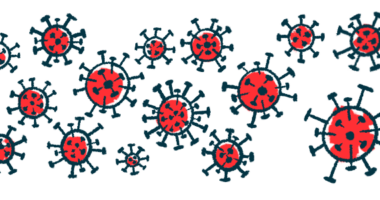Serious Mortality, Ventilation Risk Seen in IPF Patients With COVID-19

People with idiopathic pulmonary fibrosis (IPF) infected with SARS-CoV-2, the virus that causes COVID-19, are at a greater risk of severe illness leading to mechanical ventilation or death than are infected patients without this progressive lung disease, a large database study reported.
Among hospitalized individuals, however, its scientists saw no difference in outcomes between the two groups.
Still, “patients with IPF should be advised to strictly adhere to prevention guidelines,” the researchers wrote. “Consideration for prioritisation of these patients in preventative efforts like vaccination may also be considered.”
The study, “Patients with idiopathic pulmonary fibrosis have poor clinical outcomes with COVID-19 disease: a propensity matched multicentre research network analysis,” was published in BMJ Open Respiratory Journal.
SARS-CoV-2 infection primarily affects the lungs, which can increase risks for people with chronic lung diseases such as IPF, characterized by thickening and scarring (fibrosis) of lung tissue.
Data looking at the outcomes of severe COVID-19 in IPF patients, however, remains limited, and whether IPF is an independent predictor of more severe disease is unknown.
A team led by researchers at West Virginia University analyzed the clinical outcomes among 251 IPF patients with COVID-19.
They collected data from TriNetX, a research network that includes more than 40 healthcare organizations. All records of people starting at age 16 with a SARS-CoV-2 infection and diagnosed with COVID-19 between Jan. 20 and Nov. 15, 2020, were selected.
The study’s primary goal was the combined outcome of either death or the need for mechanical ventilation within 30 and 60 days from the time of SARS-CoV-2 infection or a SARS-CoV-2 positive test result, whichever occurred first.
Other outcomes, analyzed separately, included death, hospitalization, the requirement for mechanical ventilation, and acute kidney injury due to this infection. Laboratory blood test data were also assessed.
“This is the first report of COVID-19 outcomes in both hospitalised and non-hospitalised patients with IPF,” the researchers wrote.
TriNetX analysis identified 311,060 patients with SARS-CoV-2 infection during the study period. Of these, 251 (0.08%) also had IPF. The remaining 310,809 patients (99.92%) were selected as the non-IPF group.
The mean age at COVID-19 diagnosis in IPF patients was 68.3, with males making up the majority of the group (56.97%). Co-existing medical conditions were more common in those with IPF than in those without it, including chronic lower respiratory diseases, diabetes, nicotine dependence, heart disease, high blood pressure, and chronic kidney disease. Non-IPF patients had a mean age of 45.8, and females were the majority of this group (55.13%).
In the six months before SARS-CoV-2 infection, 34 IPF patients (14%) were using the antifibrotic therapy Ofev (nintedanib), and 25 (10%) Esbriet (pirfenidone).
A first analysis compared the 251 IPF patients with all 310,809 non-IPF participants. It found that people with IPF and SARS-CoV-2 infection were seven times more likely to die or need mechanical ventilation that infected patients without IPF at 30 and 60 days post-infection.
Individually, the one- and two-month mortality risk for IPF patients with COVID-19 was more than nine times higher, the risk of developing acute kidney failure or needing mechanical ventilation rose more than six times, and needing renal replacement therapy was 10 times higher. This therapy, a form of dialysis, replaces the normal blood-filtering function of the kidneys.
A second analysis adjusted data for various demographic and health-related factors (confounders), comparing the 251 IPF patients with 251 non-IPF participants. Each was individually matched — one-to-one — based on age, chronic kidney disease, diabetes, high blood pressure, chronic lung diseases, nicotine dependence, heart failure, heart disease, ethnicity, gender, and body mass index (a measure of body fat).
Here, IPF patients were 1.56 times more likely to die or need mechanical ventilation than those without IPF at 30 days post-infection, and 1.59 times more likely at 60 days. Independently, mortality risk at one and two months post-infection was about 1.5 times higher, the need for mechanical ventilation was more than twofold higher, and acute kidney failure was 1.55 times greater for those with IPF.
A significantly lower probability of survival was also seen in infected IPF patients at follow-up compared with matched patients without IPF.
Further analysis of lab blood tests among matched individuals found no differences between the groups.
Notably, a comparison of 111 hospitalized IPF patients matched with 111 hospitalized non-IPF patients also found no differences in outcomes.
“Regardless, a significantly higher composite poor outcome, critical care need and hospitalisation rate was observed in patients with IPF after matching, with lower survival. Rates of acute kidney injury were also higher in the IPF cohort [group]. Thus, COVID-19 disease carries poor outcomes in patients with coexisting IPF,” the researchers wrote.
“In conclusion, worse outcomes of COVID-19 disease were observed after robust matching of confounders,” they added. “Our data confirm that patients with IPF constitute a high-risk cohort for poor outcomes related to COVID-19 disease.”








